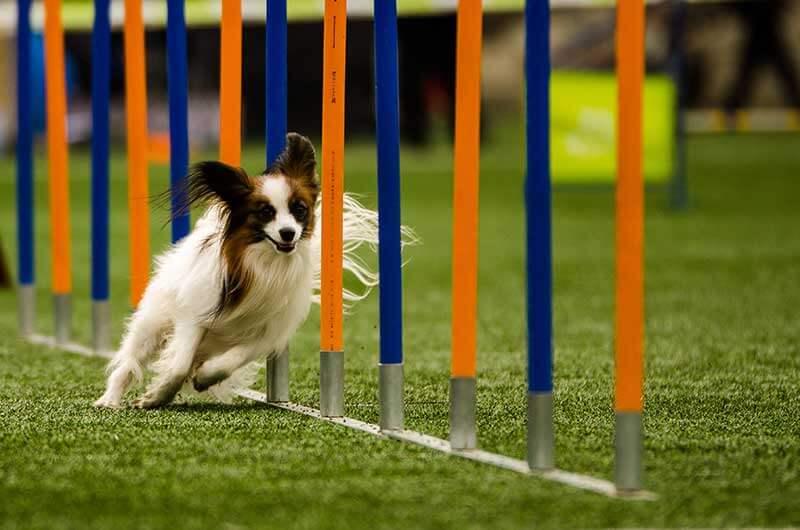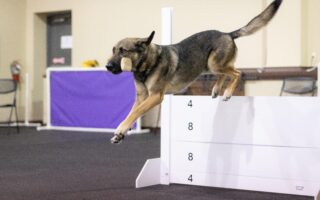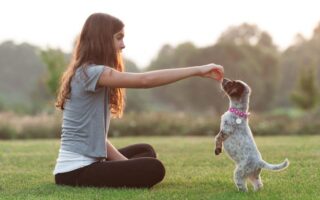Unleashing Potential: The Exciting World of Puppy Agility Training
As the sun rises and casts a golden hue over the outdoor training grounds, a symphony of playful barks fills the air. Here, amidst a maze of colorful tunnels, jumps, and weave poles, enthusiastic puppies bound with unbridled joy, eager to explore the world around them. Puppy agility training is more than just an entertaining pursuit; it’s a vibrant blend of physical exercise, mental stimulation, and quality bonding time between dogs and their handlers. In this article, we will delve into the fundamentals of puppy agility training, uncovering its benefits, exploring essential techniques, and offering insights into how to set your furry friend on the path to agility greatness. Whether you’re a seasoned dog owner or a curious newcomer, join us on this journey to discover how agility training can unleash your puppy’s potential, paving the way for a happy, active, and well-rounded companion.
Table of Contents
- Understanding the Benefits of Puppy Agility Training for Your Furry Friend
- Essential Equipment for Starting Your Puppy’s Agility Journey
- Training Techniques to Encourage Confidence and Focus in Young Agility Dogs
- Creating a Positive Environment for Effective Puppy Agility Training Sessions
- Q&A
- To Wrap It Up
Understanding the Benefits of Puppy Agility Training for Your Furry Friend
Puppy agility training offers a wealth of benefits that extend beyond the thrill of navigating obstacles. First and foremost, this type of training enhances your pup’s physical fitness. The various activities involved—such as jumping, weaving, and climbing—promote strength, coordination, and flexibility. These exercises can be especially important for growing puppies, as they contribute to a strong foundation for a healthy adulthood. Moreover, agility training helps to prevent obesity by keeping your furry friend active and engaged.
In addition to the physical advantages, agility training fosters a stronger bond between you and your puppy. Engaging in these playful activities allows for quality time together, which is essential for building trust and improving communication. As your puppy learns to navigate the courses, they also develop problem-solving skills and increased confidence, making everyday experiences less intimidating. Ultimately, the collaborative nature of agility training helps both you and your pup to thrive, ensuring a happy and fulfilling companionship.
Essential Equipment for Starting Your Puppy’s Agility Journey
Embarking on your puppy’s agility journey requires the right tools to foster their development and ensure a safe, engaging experience. The foundation of agility training lies in essential equipment that stimulates your puppy’s senses and helps them learn the basics of obstacle navigation. To kick off your training, consider investing in the following gear:
- Jump Bars: Lightweight and adjustable, perfect for introducing your puppy to jumping.
- Tunnels: Collapsible tunnels to build confidence and encourage exploration.
- Weave Poles: Simple but effective in teaching coordination and focus.
- Contact Equipment: A-frames or seesaws to prepare for more advanced challenges.
- Training Collars: Comfortable and adjustable collars that allow for proper guidance.
As you gather your tools, it’s essential to ensure they are puppy-friendly and age-appropriate. Selecting high-quality, durable equipment can make all the difference in your puppy’s agility progress. To further enhance the training experience, you might consider creating a customized agility course with varying difficulty levels. Here’s a simple layout plan to visualize your setup:
| Obstacle | Height (inches) | Purpose |
|---|---|---|
| Jump Bar | 6 | Introduction to jumping |
| Tunnel | N/A | Encourages running through |
| Weave Poles | 12 | Teaches agility and focus |
| A-Frame | 18 | Balance and climbing |
Training Techniques to Encourage Confidence and Focus in Young Agility Dogs
Building confidence in young agility dogs requires a blend of patience and effective training techniques. One method is to use positive reinforcement, rewarding your pup with treats or praise every time they successfully navigate an agility obstacle. This not only enhances their focus but also makes the experience enjoyable, allowing them to associate agility training with fun rather than pressure. Incorporating short, frequent training sessions keeps young dogs engaged and excited, reducing the chances of them becoming overwhelmed. Each session can include a mix of exercises to maintain their interest, such as:
- Simple jumps
- Tunnels
- Weave poles
In addition to varied activities, introducing socialization opportunities plays a crucial role in building a well-rounded agility dog. Exposing your pup to different environments, people, and other dogs prepares them to handle distractions during training and competitions. This can be achieved through group classes or informal playdates. Regularly practicing in new locations helps reinforce their focus and confidence as they learn to navigate both familiar and unfamiliar settings. The following strategies can be integrated into socialization outings:
| Strategy | Description |
|---|---|
| Group Training Sessions | Encourages interaction and learning with peers |
| Obstacle Courses in Parks | Familiarizes them with varied environments |
| Casual Visits to Dog-Friendly Events | Exposes them to different sounds and sights |
Creating a Positive Environment for Effective Puppy Agility Training Sessions
Establishing a nurturing atmosphere is essential for effective puppy agility training. Your puppy is keenly aware of their surroundings, so creating a positive environment can significantly enhance their experience and performance. Start by ensuring the training area is safe and free from distractions. Familiarize your pup with the space, allowing them to explore and get comfortable before diving into exercises. Incorporating elements like soft mats and age-appropriate obstacles not only enhances safety but also boosts confidence. Positive reinforcement plays a crucial role; rewarding your puppy with treats, praise, or playtime will encourage them to engage and perform their best.
Another factor to consider is the emotional state of both the trainer and the puppy. Dogs are incredibly intuitive, so approaching each session with patience and a positive attitude sets a great tone. Make use of short, structured training sessions that prevent overwhelm and burnout. Remember to vary the activities to keep things exciting. Create a routine that includes moments of fun and play, such as giving your puppy a favorite toy to use as a reward. This not only encourages a love for training but fosters a bond of trust between you two, making every session enjoyable. Here’s a simple guide to structuring your sessions:
| Session Element | Description |
|---|---|
| Warm-Up | Short walks and gentle stretches to prepare. |
| Training Focus | Choose one skill per session (e.g., jumps, tunnels). |
| Playtime | End with play to reinforce enthusiasm. |
Q&A
Q&A: Unleashing the Joy of Puppy Agility Training
Q1: What is puppy agility training?
A1: Puppy agility training is a fun and engaging activity where dogs navigate through an obstacle course consisting of jumps, tunnels, weave poles, and other challenges. It encourages physical exercise, mental stimulation, and strengthens the bond between the puppy and its owner.
Q2: At what age can I start agility training with my puppy?
A2: You can introduce your puppy to the basics of agility around six months old, when they have a good grasp of basic obedience commands. However, it’s crucial to ensure that the training is age-appropriate and that the obstacles are suitable for their size and development, focusing on fun rather than competition at this stage.
Q3: Do I need any special equipment to get started?
A3: While there are specific agility equipment sets available, you don’t need to invest in anything fancy at the beginning. Items like cones, broomsticks, and hula hoops can be creatively used to create makeshift obstacles. The key is to ensure everything is safe, sturdy, and appropriate for your puppy’s size and skill level.
Q4: Can any puppy participate in agility training?
A4: Yes! Most puppies can participate, regardless of breed, although some breeds might naturally excel due to their energy levels and physical abilities. However, it’s vital to consider each puppy’s health, temperament, and personality. Always consult with a vet if unsure about your puppy’s readiness for physical activity.
Q5: What benefits does agility training offer beyond physical exercise?
A5: Agility training provides numerous benefits! It enhances a puppy’s coordination, balance, and confidence. It also promotes mental stimulation, encouraging quick thinking and decision-making while navigating courses. Most importantly, it nurtures a strong bond between pet and owner through teamwork and shared goals.
Q6: How can I ensure my puppy enjoys agility training?
A6: To keep training enjoyable, focus on positive reinforcement! Use treats, praise, and play as rewards for completing obstacles, even small successes. Keep sessions short and enthusiastic, introducing new challenges gradually as their skills develop. Celebrate their achievements, no matter how minor, to foster a love for learning!
Q7: What common mistakes should I avoid in puppy agility training?
A7: A few common pitfalls include rushing the process, using obstacles that are too challenging, or neglecting to build a strong foundation in basic commands. It’s essential to be patient, recognizing that each puppy progresses at their own pace. Additionally, avoiding negative reinforcement is crucial; agility should remain a joyful experience!
Q8: How do I find local agility training classes?
A8: To find local agility classes, check with local pet training centers, dog clubs, or community centers that host obedience training. Online resources and social media groups can also connect you with trainers in your area. If you’re interested, inquire about introductory workshops or beginner courses to get your puppy started on their agility journey!
Q9: Can agility training prepare my puppy for competitions?
A9: Absolutely! While initial focus should be on fun and basics, agility training lays a strong foundation for competitive experiences. Once your puppy becomes accustomed to agility, you can gradually transition to advanced techniques and strategies, preparing them for future competitions if you choose to pursue that path.
Q10: Last but not least, what is the most important takeaway regarding puppy agility training?
A10: The most important takeaway is that agility training should be about nurturing a joyful experience for both you and your puppy. Celebrate the journey, embrace the challenges, and enjoy discovering the great bond of teamwork that agility can foster. Remember, at the heart of it all is the adventure of learning together!
To Wrap It Up
As you embark on this exciting journey of puppy agility training, remember that the bond you share with your furry companion is as important as the skills you cultivate together. Each jump, weave, and tunnel presents an opportunity not only for skill-building but for creating lasting memories that enrich your relationship. Embrace the challenges and the triumphs alike, knowing that every moment spent in training is a step towards a more confident and obedient pup. So, gather your equipment, lace up your shoes, and enjoy the adventure that lies ahead. With patience, consistency, and a sprinkle of creativity, you and your puppy will take on the agility course with enthusiasm and flair – one paw at a time! Happy training!



